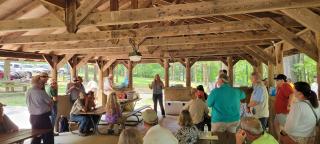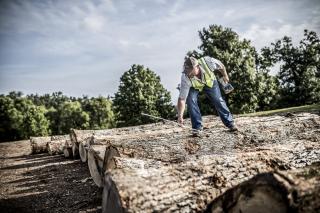Beyond the barrel: Combating the decline of the American white oak
WISCONSIN— Every bourbon trail begins in the same place: the woods. Specifically, among the millions of acres of mature American white oak in the US. White oaks are critical to the bourbon making process for storage and flavor development. So, when bourbon makers heard that white oak populations are on the decline, that caught their attention.
Beyond bourbon makers, commercially and ecologically, the American white oak is one of the most valuable resources in the eastern United States. The tree provides food and shelter for a variety of animals like birds, deer, squirrels — even bats. Commercially, the wood is a popular choice in flooring, used in furniture making and is integral to other parts of the spirits industry.
However, Forest Inventory and Analysis data shows that while there are many mature white oaks in our forests today, there are relatively few seedlings and saplings that will replace them in the future. Causes for this include competition with invasive species, changes in land use and climate change. However, the biggest threat to the future of white oak, and similarly important upland oak species, is the lack of active management that creates the conditions needed for oak seedlings to thrive.
In the Forest Service, in the puzzle of oak conservation, we work directly to conserve oak forest on National Forest System lands. Beyond NFS lands, we work through our partnerships with state agencies and other cooperators to support the implementation of oak conservation actions on nonfederal forest lands across the rural to urban continuum. We provide, as an agency, technical and financial assistance, research, conservation, education, communication policy and more to help support on-the-ground management of oak ecosystems.

And that’s where the White Oak Initiative comes in. The Eastern Region invited Jason Meyer, executive director of the White Oak Initiative, an organization dedicated to the conservation of the white oak and more broadly, upland oak ecosystems, to speak about the decline during a recent FS Talks event.
“Walking in the woods today, I hear this all the time, ‘It looks like there are plenty of white oak trees out there’,” said Meyer. “Data shows that in these areas where there are mature white oaks, there are very few seedlings coming up behind them. That's an interesting place for us to be, we have an opportunity to be proactive.”
The White Oak Initiative’s work on oak regeneration revolves around three key activities: convening, connecting and collaborating.
Most of the white oak timberland or white oak-dominated timberland is on family- or privately-owned forests. Much of the work the White Oak Initiative does is focused on those family forest landowners, helping them understand the importance of white oaks/upland oaks sustainability.
Using funding from the Forest Service and other partners, the initiative has been able to develop resources, including a guide to oak management, to help landowners understand the issue.

“We want to connect landowners with resources, whether that's educational resources, whether it's cost share resources, we want to connect forest practitioners with resources,” said Meyer. “Believe it or not, all the foresters out there in the eastern United States might not understand that there’s a problem with white oak regeneration. We want to reach those folks, too.”
White oak/upland oak management requires ongoing investments and ensuring canopy gaps or ensuring disturbance. Talking with landowners can be a bit tricky, because Meyer said they’re asking them to spend money managing their forests in ways that will allow white oak seedlings to grow for the next 80 years to maturity, but they won’t see a financial return in their lifetime.
“We know the issues. We need to move forward,” said Meyer. “We have to disturb our forests. This is key.”
A recording of Meyer’s presentation to employees is available online at FS Talks. [internal link]

